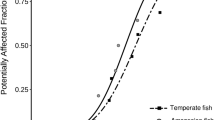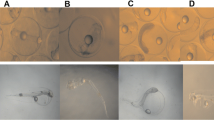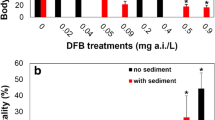Abstract
The present study evaluated the short-term toxicity of seven selected pesticides: four insecticides (chlorpyrifos, dieldrin, diazinon and pirimiphos-methyl) and three herbicides (diuron, alachlor and atrazine). With this aim, a standard toxicity test with the highly sensitive early life stages (ELS) of a marine fish was used. The turbot, Psetta maxima, is abundant in shallow estuarine and costal habitats and is currently the most commonly cultivated fish species in Galicia, NW Spain. According to the turbot ELS test results, chlorpyrifos was the most toxic pesticide tested for both embryos and larvae and was followed in order of decreasing toxicity by dieldrin, pirimiphos-methyl, diazinon, alachlor, atrazine and diuron. Larvae were more sensitive than embryos to the seven pesticides. The median lethal concentrations of the selected pesticides during a 48- and a 96-h exposure for turbot embryos and larvae were, respectively (in micrograms per litre): chlorpyrifos, 116.6 and 94.65; dieldrin, 146 and 97; pirimiphos-methyl, 560 and 452; diazinon, 1,837 and 1,230; alachlor, 2,177 and 2,233; diuron, 10,076 and 7,826; and atrazine, 11,873 and 9,957. According to their acute toxicity, the insecticides were more toxic than the herbicides. Furthermore, all insecticides and herbicides appear to be teratogenic to turbot ELS.




Similar content being viewed by others
References
Adema, D. M. M., & Vink, G. J. (1981). A comparative study of the toxicity of 1,1,2-trichloroethane, dieldrin, pentachlorophenol and 3,4-dichloroaniline for marine and freshwater organisms. Chemosphere, 10, 533–554.
AEPLA (2012). AEPLA’s public web page. Retrieved from http://www.aepla.es/. Accessed 4 April 2012.
Aguiar, L. H., Moraes, G., Avilez, I. M., Altran, A. E., & Corrêa, C. F. (2004). Metabolical effects of Folidol 600 on the neotropical freshwater fish matrinxã, Brycon cephalus. Environmental Research, 95(2), 224–230.
Aydın, R., & Köprücü, K. (2005). Acute toxicity of diazinon on the common carp (Cyprinus carpio L.) embryos and larvae. Pesticide Biochemistry and Physiology, 82, 220–225.
Banaee, M., Sureda, A., Mirvaghefi, A. R., & Ahmadi, K. (2011). Effects of diazinon on biochemical parameters of blood in rainbow trout (Oncorhynchus mykiss). Pesticide Biochemistry and Physiology, 99, 1–6.
Barbieri, E. (2009). Effect of 2,4-D herbicide (2,4-dichlorophenoxyacetic acid) on oxygen consumption and ammonium excretion of juveniles of Geophagus brasiliensis (Quoy & Gaimard, 1824) (Osteichthyes, Cichlidae). Ecotoxicology, 18(1), 55–60.
Barry, M. J., Logan, D. C., van Dam, R. A., & Holdway, D. A. (1995). Effect of age and weight-specific respiration rate on toxicity of esfenvalerate pulse-exposure to the Australian crimson-spotted rainbowfish (Melanotaenia fluviatilis). Aquatic Toxicology, 32, 115–126.
Belden, J. B., & Lydy, M. J. (2006). Joint toxicity of chlorpyrifos and esfenvalerate to fathead minnows and midge larvae. Environmental Toxicology and Chemistry, 25(2), 623–629.
Birge, W. J., Black, J. A., Westerman, A. G., & Ramey, B. A. (1983). Fish and amphibian embryos—a model system for evaluating teratogenicity. Fundamental and Applied Toxicology, 3, 237–242.
Broderius, S. J., Kahl, M. D., & Hoglund, M. D. (1995). Use of joint toxic response to define the primary mode of toxic action for diverse industrial organic chemicals. Environmental Toxicology and Chemistry, 14, 1591–1605.
Brown, M. D., Thomas, D., & Kay, B. H. (1998). Acute toxicity of selected pesticides to the pacific blue-eye, Pseudomugil signifer (Pisces). Journal of the American Mosquito Control Association, 14(4), 463–466.
Chaturvedi, L. D., & Agrawal, K. (1991). Physiological responses of fish to rogor and alachlor. Part I. General impact on Heteropneustes fossilis. Uttar Pradesh Journal of Zoology, 11, 93–102.
De Silva, P. M. C. S., & Samayawardhena, L. A. (2002). Low concentrations of lorsban in water result in far reaching behavioral and histological effects in early life stages in guppy. Ecotoxicology and Environmental Safety, 53, 248–254.
Eder, K. J., Leutenegger, C. M., Köhler, H. R., & Werner, I. (2009). Effects of neurotoxic insecticides on heat-shock proteins and cytokine transcription in Chinook salmon (Oncorhynchus tshawytscha). Ecotoxicology and Environmental Safety, 72, 182–190.
Foekema, E. M., Deerenberg, C. M., & Murk, A. J. (2008). Prolonged ELS test with the marine flatfish sole (Solea solea) shows delayed toxic effects of previous exposure to PCB 126. Aquatic Toxicology, 90, 197–203.
Gagnon, M. M., & Rawson, C. A. (2009). Diuron increases spinal deformity in early-life-stage pink snapper Pagrus auratus. Marine Pollution Bulletin, 58, 1078–1095.
Giari, L., Simoni, E., Monera, M., & Dezfuli, B. S. (2008). Histo-cytological responses of Dicentrarchus labrax (L.) following mercury exposure. Ecotoxicology and Environmental Safety, 70, 400–410.
Girón-Pérez, M. I., Santerre, A., Gonzalez-Jaime, F., Casas-Solis, J., Hernández-Coronado, M., Peregrina-Sandoval, J., Takemura, A., & Zaitseva, G. (2007). Immunotoxicity and hepatic function evaluation in Nile tilapia (Oreochromis niloticus) exposed to diazinon. Fish & Shellfish Immunology, 23, 760–769.
Görge, G., & Nagel, R. (1990). Toxicity of lindane, atrazine and deltamethrin to early life stages of zebrafish (Brachydanio rerio). Ecotoxicology and Environmental Safety, 20, 246–255.
Hallare, A., Nagel, K., Köhler, H. R., & Triebskorn, R. (2006). Comparative embryotoxicity and proteotoxicity of three carrier solvents to zebrafish (Danio rerio) embryos. Ecotoxicology and Environmental Safety, 63, 378–388.
Hamm, J. T., & Hinton, D. E. (2000). The role of development and duration of exposure to the embryotoxicity of diazinon. Aquatic Toxicology, 48, 403–418.
Hughes, J. S. (1973). Acute toxicity of thirty chemicals to striped bass (Morone saxatilis). Louisiana Wildlife and Fisheries Commission, 318-343-2417.
Humphrey, C., & Klumpp, D. W. (2003). Toxicity of chloropyrifos to early life history stages of eastern rainbowfish Melanotaenia spelndida splendida (Peters 1866) in tropical Australia. Environmental Toxicology, 18(6), 418–427.
Hutchington, T. H., Solbe, J., & Kloepper-Sams, P. (1998). Analysis of the ECETOC aquatic toxicity (EAT) database. III. Comparative toxicity of chemical substances to different life stages of aquatic organisms. Chemosphere, 36, 129–142.
Jarvinen, A. W., Nordling, B. R., & Henry, M. E. (1983). Chronic toxicity of Dursban (chlorpyrifos) to the fathead minnow (Pimephales promelas) and the resultant acetylcholinesterase inhibition. Ecotoxicology and Environmental Safety, 7, 423–434.
Kammann, U., Vobach, M., Wosniok, W., Schäffer, A., & Telscher, A. (2009). Acute toxicity of 353-nonylphenol and its metabolites for zebrafish embryos. Environmental Science and Pollution Research, 16, 227–231.
Karen, D. J., Draughn, R., Fulton, M., & Ross, P. E. (1998). Bone strength and acetylcholinesterase inhibition as endpoints in chlorpyrifos toxicity to Fundulus heteroclitus. Pesticide Biochemistry and Physiology, 60, 167–175.
Kienle, C., Köhler, H. R., & Gerhardt, A. (2009). Behavioural and developmental toxicity of chlorpyrifos and nickel chloride to zebrafish (Danio rerio) embryos and larvae. Ecotoxicology and Environmental Safety, 72, 1740–1747.
Kikuchi, M., Miyagaki, T., & Wakabayashi, M. (1996). Evaluation of pesticides used in golf links by acute toxicity test on rainbow trout. Nippon Suisan Gak Bulletin of the Japanese Society for the Science of Fish, 62, 414–419.
Kimmel, C. B., Ballard, W. W., Kimmel, S. R., Ullmann, B., & Schilling, T. F. (1995). Stages of embryonic development of the zebrafish. Developmental Dynamics, 203, 253–310.
Kumar, A., Prasad, M., Mishra, D., Srivastav, S. K., & Srivastav, A. K. (2011). Botanical pesticide, azadirachtin attenuates blood electrolytes of a freshwater catfish Heteropneustes fossilis. Pesticide Biochemistry and Physiology, 99, 170–173.
Lakra, W. S., & Nagpure, N. S. (2009). Genotoxicological studies in fishes: a review. The Indian Journal of Animal Sciences, 79, 93–98.
Lawal, M. O., & Samuel, O. B. (2010). Investigation of acute toxicity of pirimiphos-methyl (Actellic®, 25%EC) on guppy (Poecilia reticulate, Peters, 1859). Pakistan Journal of Biological Sciences, 13(8), 405–408.
Macek, K. J., Buxton, K. S., Sauter, S., Gnilka, S., & Dean, J. W. (2003). Chronic toxicity of atrazine to selected aquatic invertebrates and fishes. EPA 600/3-76-047. Duluth, MN: U.S. Environmental Protection Agency.
Mensink, B. J. W. G. (2008). Environmental risk limits for pirimiphos-methyl. Letter Report, 601716011/2008.
Mhadhbi, L., Boumaiza, M., & Beiras, R. (2010). A standard ecotoxicological bioassay with early life stages of the marine fish Psetta maxima. Aquatic Living Resources, 23(2), 209–216.
Mhadhbi, L., Fumega, J., Boumaiza, M., & Beiras, R. (2012). Acute toxicity of polybrominated diphenyl ethers (PBDEs) for turbot (Psetta maxima) early life stages (ELS). Environmental Science and Pollution Research, 19, 708–717.
Modra, H., Vrskova, D., Macova, S., Kohoutkova, J., Hajslova, J., Haluzova, I., & Svobodova, Z. (2011). Comparison of diazinon toxicity to embryos of Xenopus laevis and Danio rerio: degradation of diazinon in water. Bulletin of Environmental Contamination and Toxicology, 86, 601–604.
Nebeker, A. V., & Schuytema, G. S. (1998). Chronic effects of the herbicide diuron on freshwater cladocerans, amphipods, midges, minnows, worms, and snails. Archives of Environmental Contamination and Toxicology, 35, 441–446.
Neškovic, N. K., Elezonic, I., Karan, V., Poleksic, V., & Budimir, M. (1993). Acute and sub acute toxicity of atrazine to carp (Cyprinus carpio). Ecotoxicology and Environmental Safety, 25, 173–182.
Nwani, C. D., Lakra, W. S., Nagpure, N. S., Kumar, R., Kushwaha, B., & Srivastava, S. K. (2010). Toxicity of the herbicide atrazine: effects on lipid peroxidation and activities of antioxidant enzymes in the freshwater fish Channa punctatus (Bloch). International Journal of Environmental Research and Public Health, 7(8), 3298–3312.
OECD. (1998). Guidelines for the testing of chemicals. Section 2: Effects on biotic systems test no. 212: Fish, short-term toxicity test on embryo and sac-fry stages. Paris: Organization for Economic Cooperation and Development.
Peakall, D. B. B. (1996). Dieldrin and other cyclodiene pesticides in wildlife. In W. N. Beyer, G. H. Heintz, & A. W. Redmon-Norwood (Eds.), Environmental contaminants in wildlife, interpreting tissue concentrations (pp. 73–97). Boca Raton, FL: SETAC, Lewis.
PED (2000). Pesticide ecotoxicity database [formerly: environmental effect database (EECD)]. Environmental Fate and Effects Division, US EPA, Washington, DC.
Peebua, P., Kruatrachue, M., Pokethitiyook, P., & Singhakaew, S. (2008). Histopathological alterations of Nile tilapia, Oreochromis niloticus in acute and subchronic alachlor exposure. Journal of Environmental Biology, 29(3), 325–331.
Pesando, D., Robert, S., Huitorel, P., Gutknecht, E., Pereira, L., Girard, J. P., & Ciapa, B. (2004). Effects of methoxychlor, dieldrin and lindane on sea urchin fertilization and early development. Aquatic Toxicology, 66, 225–239.
Phillips, T. A., Wu, J., Summerfelt, R. C., & Atchison, G. J. (2002). Acute toxicity and cholinesterase inhibition in larval and early juvenile walleye exposed to chlorpyrifos. Environmental Toxicology and Chemistry, 21, 1469–1474.
Phillips, T. A., Summerfelt, R. C., Wu, J., & Laird, D. A. (2003). Toxicity of chlorpyrifos adsorbed on humic colloids to larval walleye (Stizostedion vitreum). Archives of Environmental Contamination and Toxicology, 45, 258–263.
Phyu, Y. L., St, M., Warne, J., & Lim, R. P. (2006). Toxicity and bioavailability of atrazine and molinate to the freshwater fish (Melanotenia fluviatilis) under laboratory and simulated field conditions. Science of the Total Environment, 356, 86–99.
Rao, J. V., Begum, G., Pallela, R., Usman, P. K., & Rao, R. N. (2005). Changes in behavior and brain acetylcholinesterase activity in mosquito fish, Gambusia affinis in response to the sub-lethal exposure to chlorpyrifos. International Journal of Environmental Research and Public Health, 2(3), 478–483.
Sharma, R. M. (1990). Effect of endosulfan on acid and alkaline phosphatase activity in liver kidney, and muscles of Channa gachua. Bulletin of Environmental Contamination and Toxicology, 44, 443–448.
Sparling, D. W., & Fellers, G. (2007). Comparative toxicity of chlorpyrifos, diazinon, malathion and their oxon derivatives to larval Rana boylii. Environmental Pollution, 147, 535–539.
USEPA (1986). Ambient water quality criteria for chlorpyrifos—1986. U.S. Environmental Protection Agency Report 440/5-86-005, 64 pp.
USEPA (1999). Office of Prevention, Pesticides and Toxic Substances. EFED RED chapter for diazinon. Case no. 818962. Retrieved from http://www.epa.gov/pesticides/op/diazinon/efedrisk.pdf. Accessed 4 April 2012.
Zucker, E. (1985). Hazard Evaluation Division—Standard evaluation procedure—acute test for freshwater fish. U.S. EPA Publication 540/9-85-006.
Acknowledgments
The authors gratefully acknowledge the cooperation of all the workers and personnel at the ECIMAT and Laboratory of Marine Ecology, especially those workers who willingly participated in the hatchery, Damián Costas and Arantxa Martínez. The authors would like to thank David Chavarrias (Insuiña S.L., Mougás, Galicia, Spain). This study was financially supported by MAE-PCI (Ministry of Foreign Affairs, Spain), Ministry of Higher Education, Scientific Research and Technology in Tunisia and the Spanish Ministry of Science and Innovation (MCINN) through the research project Environmental Quality Criteria for Marine Ecosystems (ENVICRISYS).
Author information
Authors and Affiliations
Corresponding author
Additional information
An erratum to this article is available at http://dx.doi.org/10.1007/s11270-016-2980-2.
Rights and permissions
About this article
Cite this article
Mhadhbi, L., Beiras, R. Acute Toxicity of Seven Selected Pesticides (Alachlor, Atrazine, Dieldrin, Diuron, Pirimiphos-Methyl, Chlorpyrifos, Diazinon) to the Marine Fish (Turbot, Psetta maxima). Water Air Soil Pollut 223, 5917–5930 (2012). https://doi.org/10.1007/s11270-012-1328-9
Received:
Accepted:
Published:
Issue Date:
DOI: https://doi.org/10.1007/s11270-012-1328-9




